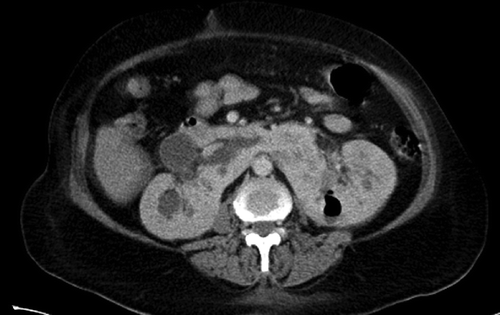Sir
Emphysematous pyelonephritis (EPN) in association with horseshoe kidney is a rare observation. The review of literature revealed only a single report of this nature.Citation1 Keeping this in view, we describe a diabetic patient who was found to have EPN in horseshoe kidney.
Horseshoe kidney is a renal fusion anomaly with male predominance and prevalence being 1 in 400 births. In this anomaly the kidneys are connected by a parenchymatous or fibrous isthmus that crosses the midline. Embryologically the abnormality originates between the fourth and sixth weeks of gestation when the inferior portion of the metanephric blastema fuses before the ascent and rotation of the kidneys. The isthmus of the fused tissue encroaches on the inferior mesenteric artery, preventing further migration of the kidneys. In imaging the features of horseshoe kidney include caudal renal position, malrotation with reversed longitudinal axis of each kidney, and anterior extra renal pelvis. Horseshoe kidney is associated with an increased rate of infection, obstruction, stone formation, and renal tumors.Citation2
Figure 1. Computerized tomography with contrast showing horseshoe kidney with fusion of lower poles and air in left kidney.

EPN is an acute bacterial infection of the kidney potentially life threatening with a reported mortality of 40% to 90%. EPN is characterized by intrarenal and occasionally perirenal gas formation by lactose-fermenting bacteria such as Escherichia coli, Klebsiella, or Aerobacter. Diabetics are prone for EPN.Citation3
CASE REPORT
A 60-year-old female, diabetic for 6 years, presented with history of fever, pyuria, and oliguria. Evaluation revealed hyperglycemia, hypotension, polymorpholeucocytosis, thrombocytopenia (49,000/cumm), metabolic acidosis (pH 7.21, Hco3-11Meq, pco2-19 mmHg), and severe renal failure (serum creatinine 6.8 mg/dL, acute kidney injury network-3 (AKIN-3)). Urine examination showed plenty of pus cells (no pus cell casts) and urine culture grew E. coli. The abdomen ultrasound revealed suspicion of horseshoe kidney with presence of gas in renal parenchyma with no urinary tract obstruction which was confirmed on CT evaluation (). The patient received hemodialysis support for the management of renal failure and metabolic acidosis along with antibiotic support. She was discharged following improvement with serum creatinine of 1.7 mg/dL.
In conclusion we present a rare association of EPN occurring in horseshoe kidney resulting in severe sepsis and acute kidney injury in a diabetic and with successful outcome following antibiotic and dialysis support.
REFERENCES
- d’Escrivan T, Duval A, Faure K. Severe emphysematous pyelonephritis on a horseshoe kidney. Méd Mal Infect. 2006; 36:432–433.
- Strauss S, Dushnitsky T, Peer A, Manor H, Libson E, Lebensart PD. Sonographic features of horseshoe kidney. J Ultrasound Med. 2000;19:27–31.
- Shokeir AA, El-Azab M, Mohsen T, El-Diasty T. Emphysematous pyelonephritis: A 15-year experience with 20 cases. Urology. 1997;49(3):343–346.
